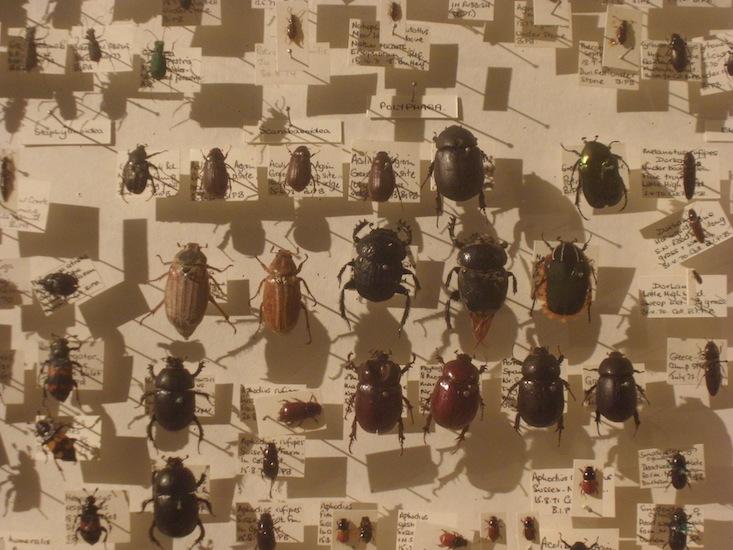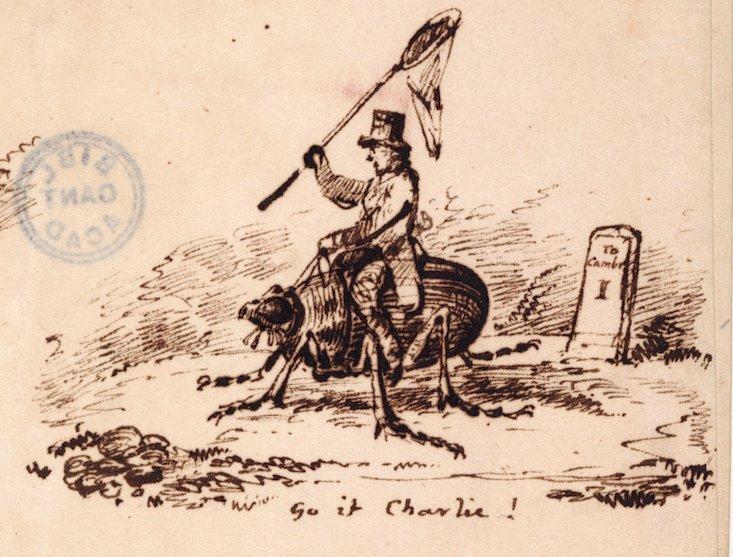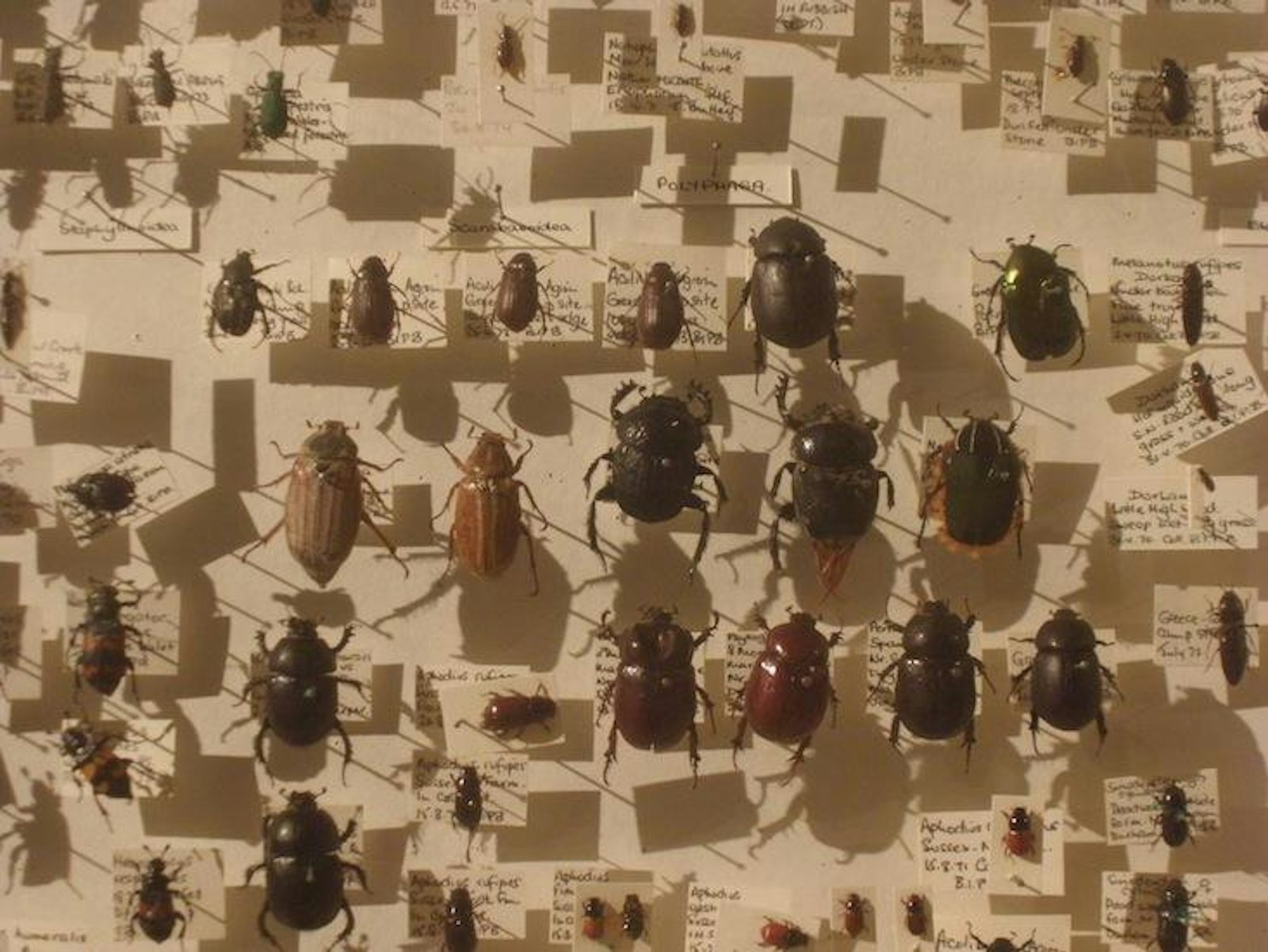
On August 24, 1832, HMS Beagle dropped anchor at Bahía Blanca, a deep natural harbor in present-day Argentina. On board was a 23-year-old naturalist, Charles Darwin. He had been at sea since December 27, 1831, when the Beagle left Plymouth. Darwin had spent most of those months incapacitated with seasickness. During one bout of nausea, staring sadly down at a long, slow inescapable swell unfurling below him, he wrote, “This & three following days were ones of great & ceaseless suffering.”
A few days before arriving at Bahía Blanca, Darwin had sent his first shipment of specimens home to Cambridge. Among them were four bottles of animals in preservative, rocks and tropical plants, several marine animals, and many, many beetles. On the coast, at Bahía Blanca, Darwin continued collecting specimens. Among the material was an unusually large species of rove beetle with a long, segmented body and an iridescent blue-green head. There, too, in the sandy ground near the harbor, he found numerous fossilized animal remains, which he described in detail in The Voyage of Beagle. He sent everything back to England.
But the beetle disappeared. Then in 2012, 180 years after Darwin collected it in Argentina, Stelios Chatzimanolis found it again.
Chatzimanolis was one of just a handful of people in the world—perhaps the only person—who could tell at a glance that the beetle was misplaced.
“It’s an impressive beetle,” says Chatzimanolis, an entomologist at the University of Tennessee at Chattanooga. First, for a rove beetle it’s large. With its long, flexible segmented abdomen, it closely resembles a large and brightly colored earwig, which it is not. Its size sets it apart, but so does its appearance. Most rove beetles, he says, are dark brown or black. This one has a glittering blue-green head. Other key morphological characteristics stand out too. “It has what we call serrate antennae, like a saw,” says Chatzimanolis, “which is not seen in other species or in other genera in the sub-group it belongs to.”
Coleoptera, the animal order that includes all beetles, consists of more than 400,000 known species. By comparison, the entire Chordata phylum, which encompasses all animals with a backbone—fishes, amphibians, reptiles, birds, and mammals—numbers around only 65,000 known species. Within Coleoptera, rove beetles are members of a single family of beetles: the Staphylinidae. By itself it’s an enormous group of beetles. There are about 60,000 named species of rove beetles; no one can possibly know them all. Taxonomically the Staphylinidae family is further divided into several subfamilies; the subfamilies are separated into tribes; the tribes are split into subtribes; and subtribes are then divided into genera and species.
Chatzimanolis is an insect systematist, and he is not a generalist. He’s like a cartographer who, when asked to map out a sprawling megacity, instead traces in the minutest detail every building and street in a neighborhood on its outskirts and leaves the rest of the map totally blank. He specializes in a subtribe of rove beetles called Xanthopygina. In February 2012 Chatzimanolis was working on a revision of the Trigonopselaphus genus—a relatively small group of neotropical rove beetles contained within the Xanthopygina subtribe. When taxonomists embark on the revision of a genus, they often discover new species. They find discrepancies: specimens that were misidentified and placed into the wrong genus are reclassified; several named species are found to be a single species, which has been described again and again by different taxonomists. Species that once were named and then combined with others are resurrected. For the revision, Chatzimanolis requested all the unspecified Trigonopselaphus material from the Natural History Museum in London. The specimens arrived by mail in a small box. Inside the box were 24 pinned beetle specimens, all supposedly belonging to the Trigonopselaphus genus. Among them, misidentified, was the specimen Darwin collected at Bahía Blanca in 1832.
Suddenly the beetle had resurfaced. It’s difficult to overstate the importance of finding an original Darwin specimen, collected during the Beagle’s first voyage.

But where had it been for 180 years? It disappeared amid an enormous collection of millions of other insects, built over centuries. By 1987 it was listed as lost in “Darwin’s Insects: Charles Darwin’s Entomological Notes.” Darwin had even assigned it a specimen number: 708. But it was gone. Searching for it would be like looking for a specific stalk in a towering haystack. “The Natural History Museum in London is not a small place,” Chatzimanolis says. “They have millions and millions of specimens. If you misplace something, the chances of finding it there again are near zero.”
Chatzimanolis was one of just a handful of people in the world—perhaps the only person—who could tell at a glance that the beetle was misplaced. “I was able to easily figure out that this was not Trigonopselaphus,” he says. “This is something new.” Then he realized it was a Darwin specimen.
Finding the beetle and realizing it was a lost specimen collected by Darwin was just the first step in a much longer journey. He put aside the revision he was working on and concentrated instead on describing the lost beetle—its unusual serrate antennae curving away from its gleaming head.
“Being atypical by itself does not guarantee that a beetle is going to be described as a new species,” he tells me. “The biggest hurdle we have to jump when we try to describe a new species is to get at where it belongs. That’s the hardest job we have as taxonomists. We first have to learn everything that has been described so that when we see something new we’ll be able to recognize it as new and be able to describe it.”
In February 2014 Chatzimanolis gave the beetle the scientific name Darwinilus sedarisi and published his findings in the journal ZooKeys. It is named for Darwin and for the writer David Sedaris, whose audiobooks Chatzimanolis listened to while writing the description.
In the 180 years since Darwin collected the rove beetle, the place it came from has changed drastically. The landscape has been transformed by humans. It has been shaped, cultivated, deforested—altered in profound ways. Chatzimanolis doesn’t know if the beetle still exists. After struggling to find specimens in other collections, he suspects it is extinct. “The type locality has been converted to agricultural fields,” he says. “If this is a species with a narrow distribution, it’s gone.”
Finding an undescribed species in a museum collection is not an unusual event, says Chatzimanolis. When, by some estimates, only one in four living insect species has been described and named, it’s an expected outcome. Millions of insect species still await description. An unknown number wait in natural history collections. “I’m sitting in my office” he says quietly, “and behind me is a 20-drawer cabinet that probably contains more than a hundred new species.”
Christopher Kemp is a scientist living in Grand Rapids, Michigan. He is the author of Floating Gold: A Natural (and Unnatural) History of Ambergis.
Reprinted with permission from The Lost Species: Great Expeditions in the Collections of Natural History Museums by Christopher Kemp, published by Chicago University Press.
© 2018 Christopher Kemp. All rights reserved.


























